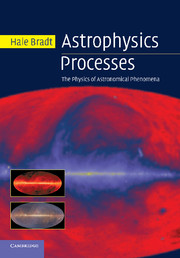Book contents
- Frontmatter
- Contents
- List of figures
- List of tables
- Preface
- Acknowledgments
- Also by the author
- 1 Kepler, Newton, and the mass function
- 2 Equilibrium in stars
- 3 Equations of state
- 4 Stellar structure and evolution
- 5 Thermal bremsstrahlung radiation
- 6 Blackbody radiation
- 7 Special theory of relativity in astronomy
- 8 Synchrotron radiation
- 9 Compton scattering
- 10 Hydrogen spin-flip radiation
- 11 Dispersion and Faraday rotation
- 12 Gravitational lensing
- Credits, further reading, and references
- Glossary
- Appendix: Units, symbols, and values
- Index
9 - Compton scattering
Published online by Cambridge University Press: 05 June 2012
- Frontmatter
- Contents
- List of figures
- List of tables
- Preface
- Acknowledgments
- Also by the author
- 1 Kepler, Newton, and the mass function
- 2 Equilibrium in stars
- 3 Equations of state
- 4 Stellar structure and evolution
- 5 Thermal bremsstrahlung radiation
- 6 Blackbody radiation
- 7 Special theory of relativity in astronomy
- 8 Synchrotron radiation
- 9 Compton scattering
- 10 Hydrogen spin-flip radiation
- 11 Dispersion and Faraday rotation
- 12 Gravitational lensing
- Credits, further reading, and references
- Glossary
- Appendix: Units, symbols, and values
- Index
Summary
What we learn in this chapter
The normal Compton effect involves the collision of a photon with a nearly stationary electron. In the inverse process, a high-energy electron gives energy to a photon. This process, known as inverse Compton (IC) scattering, is important in the jets of active galactic nuclei and in clusters of galaxies.
Momentum and energy conservation yield the energy and scattered angle of the electron in the normal effect. The increase of the photon energy in the IC process follows from the application of the normal effect in the rest frame of the energetic incident electron. The final result is that a relativistic electron with Lorentz factor γ = U/mc2 will increase the photon energy by a factor of ∼γ2. In jets, for example, this can propel x-ray photons up to extreme gamma-ray energies detected by TeV gamma-ray astronomers. The modification of photon spectra due to single or multiple IC scatters is called Comptonization.
Energetic electrons in a nebula containing magnetic fields will radiate by the synchrotron process. The synchrotron photons may then interact with the energetic electrons that created them via the IC process and thus be boosted to extremely high energies. This is known as the synchrotron self-Compton (SSC) process. […]
- Type
- Chapter
- Information
- Astrophysics ProcessesThe Physics of Astronomical Phenomena, pp. 329 - 354Publisher: Cambridge University PressPrint publication year: 2008



